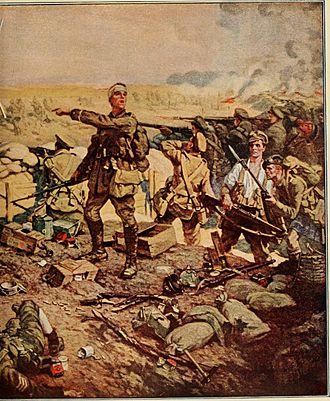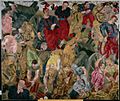Second Battle of Ypres facts for kids
Quick facts for kids Second Battle of Ypres |
|||||||
|---|---|---|---|---|---|---|---|
| Part of the Western Front of the First World War | |||||||
|
Canadian troops in the battle |
|||||||
|
|||||||
| Belligerents | |||||||
| Commanders and leaders | |||||||
| Strength | |||||||
| 8 infantry divisions—2 French divisions and 6 British, Canadian, and Newfoundland divisions | 7 infantry divisions | ||||||
| Casualties and losses | |||||||
| 70,000 dead, wounded, or missing | 35,000 dead, wounded, or missing | ||||||
The Second Battle of Ypres was a battle of the First World War. It was fought for control of the town of Ypres in western Belgium. It happened in the spring of 1915. It was the first time that Germany successfully used chemical weapons on a large scale on the Western Front. It was also the first time a former Colonial power defeated a major European power in European soil. The battle was the beginning of a new danger; gas, which will cost both sides thousands of casualties the rest of the war.
Contents
Prelude
During the months of April and May 1915, the two sides fought over Hill 60. The allies captured the hill five days before the Second battle of Ypres began. Hill 60 was on the southeast edge of the Ypres Salient. It was an excellent Observation post to see the salient. Hill 60 would also be involved in the battle that followed.
The Geneva Conventions of 1899 and 1907 had not allowed "projectiles" that carried poison gas. Before the second battle at Ypres, the Germans had placed 5,700 chlorine gas cylinders in front of their trenches. For weeks before the battle, the allied high command picked up intelligence the Germans intended to use poison gas. However, they didn't believe the Germans would do it.
Gas attacks
The first casualties of the chlorine gas attack in World War One were the French (mostly Algerian soldiers). They were not trained for this kind of attack. When the first Chlorine gas was released into the air, the French began to retreat in massive numbers. This left the Canadians without any French support. It also left their center open to any German attack. But the Germans were unprepared for the results of the gas attack. Their reserves of manpower were low and they failed to take advantage of the French Withdrawal. The 1st Canadian Division and British troops quickly filled the gap in the lines to stop the Germans from attacking.
When the gas valves froze (from the rapidly expanding gas), many German soldiers tried to open them. This left the Germans exposed to the Gas as well. By the end of the battle the Allies and Germans had suffered massive casualties in the attack. The Canadians alone suffered over 6000 casualties. Gas masks were none existent at the time. But a Canadian Ceramic maker was able to recognize the color of the gas. He immediately told the soldiers to urinate on a towel and put it over their face. This isolated (separated) the gas components and stopped the gas from killing the Canadian soldiers.
This was actually the second time the Germans had used gas against enemy troops. The first attempt was at the Battle of Bolimov, Russia in February 1915. The freezing temperatures caused the gas to fall to the ground harmlessly.
Images for kids
-
Fritz Haber, a German chemist who proposed the use of the heavier-than-air chlorine gas as a weapon to break the trench deadlock
-
Langemark-Poelkapelle: Photograph taken from a position just west of Langemark German war cemetery, facing approximately north, towards the former location of the German trench from which the first gas attack was launched on 22 April 1915. In this area, the German trench system ran approximately from the farmhouse on the left to the group of willow trees on the right. -
Grave in Kells, County Meath, Ireland of a Leinster Regiment soldier who died at Bellewaarde
See also
 In Spanish: Segunda batalla de Ypres para niños
In Spanish: Segunda batalla de Ypres para niños








